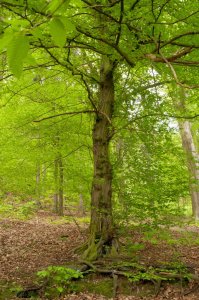
Hornbeam (Carpinus betulus)

| Occurrence in Děčín |
Grows
in many parks. A typical example of the use of hedges is the park in Wolker
Street, where in the 1960s the hornbeam fence grew almost all around the park,
and the entrances were hornbeam gates. Beautiful specimens can be found in the
Arboretum in Kvádrberk, in the aforementioned Wolkerova Street, but the largest
hornbeams can be seen in the forest park above the Industrial Park in Letná
(trunk circumference up to 260cm). After all, an interesting location is the
nearby grove at the end of Slovanská Street, where almost exclusively hornbeams
grow. They are planted in rows, and originally apparently formed hedges. After
their cutting was abandoned, the hornbeams grew and formed bizarre tribes.
Local children have named the location many years ago as "Magic
Forest". Interesting individuals can be found in the Bažantnice Forest
Park and, of course, here on Pastýřská stěna. |
| Application |
used
in groups and separately. Due to the fact that it is well tolerated cut in the
Renaissance, but especially in the baroque used for hedges and walls. The most
frequently used solitaires are its cultivars, especially cv. ´Pendula´.
Hornbeam trunks are often very bizarre shapes, especially old specimens of
former hedges that have ceased to be maintained. |
| Habitat |
in our country it grows mostly in lower altitudes, on hills and foothills. It is most commonly found in oak-hornbeam or beech-hornbeam communities, sometimes in continuous stands - hornbeams. It thrives on damper loamy to medium-heavy soils; it can withstand drier habitats and lighter soils. It is frost resistant. |
| Location |
Europe,
Caucasus, extends to Asia Minor |
| Fruits |
achenes
with 3-lobed ailerons, side lobes shorter, often serrated; achenes broadly
ovate, ribbed. It consists of 7-14cm long fruit. |
| Blossom |
single-sex,
male are catkins on last year's shoots, female upright on shoots. |
| Leaves |
Elliptic
to ovate, 5-10cm long, lumpy, cordate, irregularly double serrate, dark green
above, initially silky hirsute, lighter underneath, hairy petiole, petiole
0.6-1.3cm long on veins. Autumn color golden yellow. Leaves of young trees
persist until spring. |
| Branches | young, thin, slightly wavy, green, hairy, older olive green to reddish-brown, and glabrous with numerous lenticelami. On the cross-section rounded five angular. |
| Rind |
bark at first rough, and gray-black, later smooth, gray,
longitudinally grooved. |
| Treetop | Up to 25m tall tree, crown at first conical, later widely spread. Old specimens may be up to 1m thick, but they are often multi-stemmed with weaker trunks. |
| Note |
Our most interesting hornbeam grows in the middle of
Libáňská pheasantry in Jičín region. It is a polycormon, a cluster of several
strains, the circumference of which is 130cm above the ground and is 567cm
high, 24m high. Its age is estimated at 400 years (it will probably be
exaggerated). Probably a tree that used to be part of a hedge and grew out of a
tree stump after it was abolished. It has an interesting reputation. Probably
the most beautiful specimen of the overhanging form of hornbeam (Carpinus
betulus Pendula´) grows in the city park in Česká Lípa. It stands next to the
Art Nouveau music pavilion of 1882 and has a trunk diameter of nearly 1m. As
already mentioned, hornbeam is used to create hedges, also popular for planting
mazes (labyrinths), for example in the Flower Garden in Kromeriz. A remarkable
maze is part of the J.A.Komenský Memorial near Brandýs n.O., which is inspired
by his publication "Labyrinth of the World and Paradise of the
Heart". |





